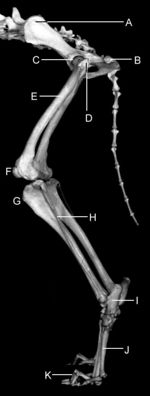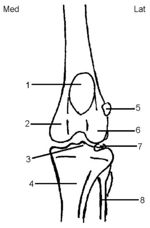Canine Hindlimb - Anatomy & Physiology
Pelvic Girdle and Hip
The pelvis encircles the pelvic cavity and has several functions including protecting the pelvic viscera, and the reproductive and urinary organs. The pelvis is also essential in locomotion and posture. The pelvis also contains the pelvic canal which, dependant on size, can cause problems during parturition.
Bones
The pelvic girdle is formed by two hip bones which are joined ventrally at the cartilagenous pelvic symphysis and articulate dorsally with the sacrum. The three components of each hip bone are the ilium, pubis and ischium.
The bone that articulates with the hip bones to form the hip joint is the femur.
Canine Bone Specifics
The ilium is large and prominent in canines. In the dog the tuber coxae has two prominences; the cranial and caudal ventral iliac spines and although not usually visible, both are readily palpable. The sacral tuber has two prominences; the cranial and caudal dorsal iliac spines. The iliac crest is wide and convex and the ileal wing is orientated in an almost sagittal manner and both are easily palpable.
Within the the ischium, the canine ischial tuberosity is linear in shape.
The femoral head of the canine femur is circular and is situated in the centre of the head. There is a distinct neck connecting the femoral head to the shaft and the greater trochanter is level with the femoral head.
Joints and Synovial Structures
Sacroiliac Joint
In dogs, the short branch of the dorsal sacroiliac ligaments connects the sacral tuberosity to the mamillary processes of the sacrum. The sacrotuberous ligament consists of a fibrous cord between the ischial tuberosity and the transverse process of the last sacral vertebrae. (This ligament is absent in the cat.)
Coxafemoral/Hip Joint
The dog has the greatest range of movement in this joint compared to other domestic species. It has the ability to flex, extend, rotate, adduct and abduct its whole limb because of this.
Musculature
The muscles affecting the pelvic girdle and hip can be divided into two distinct groups: the girdle musculature and the rump muscles.
The girdle musculature has two prominent muscles. The psoas minor is a strong fleshy muscle and the tendon of insertion is bound to the iliac fascia and attaches to the arcuate line of the ilium. The quadrate lumbar is stronger in canines relative to other domestic species. It has both a thoracic and lumbar part. The thoracic part originates from the bodies of the last three thoracic vertebrae and inserts on the transverse processes of the cranial lumbar vertebrae.
There are a number of muscles contained within the rump muscles. The superficial gluteal originates within the gluteal fascia, lateral aspect of sacrum, sacral tuber of ilium, first caudal vertebra and the sacrotuberous ligament. It inserts via a tendon running caudodistally over the greater trochanter and inserting just distal to it. The middle gluteal originates between the iliac crest and gluteal line of the ilium and inserts on the greater trochanter. The tensor muscle of the fascia lata originates on the ventral aspect of iliac spine and aponeurosis of the middle gluteal and inserts via the fascia lata to the patella. This muscle fans out into the fascia lata and is bordered by the middle gluteal dorsally and the sartorius muscle cranially. The biceps originate from the cranial superficial head of the sacrotuberous ligament and the from the lateral aspect of iscial tuberosity on the caudal head. The two muscle bellies of the biceps unite at an aponeurosis attached to the stifle and crural fascia and this fascia then inserts on the patella, patella ligament, and tibial tuberosity. A distal tendon of the muscle separates from the main muscle belly and passes under the adductor and along the gastrocnemius. It moves in front of the calcaneal tendon and combining with a tendon of the semitendinous muscle inserts on the calcaneal tuberosity. The semitendinous muscle originates from the caudal and ventrolateral aspect of the ischial tuberosity between the heads of the biceps and semimembranous muscle. It then inserts via a strong tendon to the cranial aspect of the tendon. An accessory tendon, as mentioned above, also attaches to the calcaneal tuberosity.
The semimembranous muscle originates from the ventral aspect of the ischium and inserts via a short tendon to the aponeurosis of the gastrocnemius and via a longer tendon to the medial femoral condyle and medial tibial condyle. The cranial element of the sartorius muscle originates on the iliac crest and unites with the femoral fascia and stifle fascia. The caudal part originates from the ventral iliac spine and joins the aponeurosis of the gracilis on the cranial aspect of the tibia. The pectineal muscle originates from a fleshy origin from the iliopubic eminence and a tendinous origin from the prepubic tendon. The pectineal then inserts via a tendinous attachment to the popliteal surface of the femur. The adductor muscles contain a number of smaller specific muscles with differing origins and insertions. The greater adductor muscle originates from the pelvic symphysis and prepubic tendon and inserts on the popliteal fossa and the lateral supracondylar tuberosity. The short adductor originates on the pubic tubercle and inserts on the caudal aspect of the femur. The long adductor is fused to the pectineal. (This remains unfused in cats). Finally, the internal obturator originates from the ischium, pubis and ischiatic arch and covers the obturator foramen. It inserts on the trochantic fossa via a strong tendon that passes over the lesser sciatic notch.
Proximal Hindlimb including Stifle and Tarsus
Bones
The bones immediately distal to the femur are the tibia, fibula, patella and some minor sesamoid bones. Some of these are involved in the stifle joint, weight-bearing and providing attachment for muscles.
Distal to these bones are the complex series of bones that make up the tarsus, these are the tarsal bones and metatarsals.
Canine Bone Specifics
Within the tibia, the cochlea has a lateral notch for the articulation with the fibula.
In canines, the fibula has maintained its entire length but still has reduced strength and function. The interosseous space separates the tibia from the fibula proximally and this gap is bridged by soft tissue. In thin dogs the entire bone is palpable but in heavy-set dogs only the proximal extremity is plalpable. The fibular head articulates with the lateral condyle of the tibia.
Within the talus the trochlea ridges are less pronounced and extend further distally than other species allowing for increased mobility. The trochlea also articulates with the distal fibula and medial malleolus. The body and head of the talus are separated by a well defined neck.
The canine distal row of tarsal bones still contain the original number of 5 bones and has the central bone, 1st, 2nd, 3rd and 4th tarsal bones.
Joints and Synovial Structures
The canine stifle joint posesses a transverse ligament of the menisci. It also possesses one patellar ligament that is formed from the distal insertion of the quadriceps and connects the patella to the tibial tuberosity. It is seperated from the joint capsule by the infrapatellar fat pad. There is often a synovial bursa between the distal part of the ligament and the tibial tuberosity. The medial and lateral femoropatellar ligaments extend from the patellas to the femoral epicondyles and also have attachments to the fabella. These are two small sesamoid bones that are embedded in the head of the gastrocnemius muscle. The joint capsule communicates directly with the femorotibial joint forming three sacs. One for the femoropatellar and one each for the medial and lateral femorotibial. These also contain the fabellae. The lateral pouch is extended to form the proximal tibiofibular joint capsule.
The canine tarsal joint/hock has lateral movement as well as flexion and extension in their proximal intertarsal joints. The short medial collateral ligament has an extra branch in dogs that extends to the medial metatarsal bones.
Musculature
The muscles of the stifle in canines have quadriceps divisions less well defined than in other species and the popliteal tendon of origin contains a sesamoid bone in carnivores.
Muscles of the Canine Crus
Vasculature of the Hindlimb
| Canine Hindlimb - Anatomy & Physiology Learning Resources | |
|---|---|
 Test your knowledge using drag and drop boxes |
Canine muscular anatomy |
 Selection of relevant programmes to enhance your knowledge |
Canine Radiographs programme, look at complete canine skeleton |
Anatomy Museum Resources |
Muscle flashcards - muscles of the canine hindlimb Muscle flashcards - muscles of the canine hip |
Error in widget FBRecommend: unable to write file /var/www/wikivet.net/extensions/Widgets/compiled_templates/wrt69361eed2d2625_53189655 Error in widget google+: unable to write file /var/www/wikivet.net/extensions/Widgets/compiled_templates/wrt69361eed396e08_86826722 Error in widget TwitterTweet: unable to write file /var/www/wikivet.net/extensions/Widgets/compiled_templates/wrt69361eed4a6824_48864818
|
| WikiVet® Introduction - Help WikiVet - Report a Problem |

